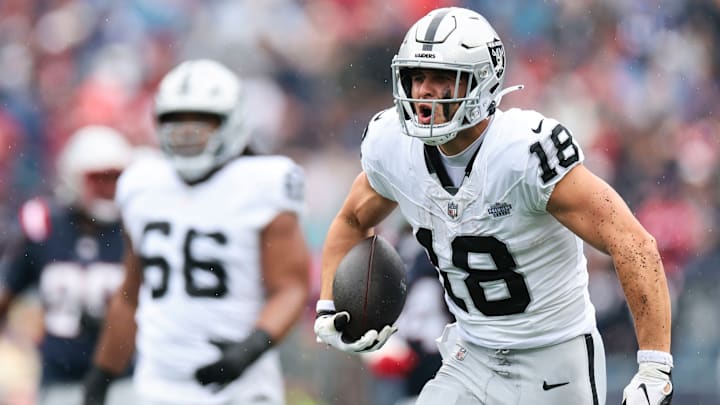Four weeks into the season, the Las Vegas Raiders’ pair of rookie wideouts, Jack Bech and Dont’e Thornton Jr., have experienced opposite trajectories in usage and production, each shaped as much by their own performance as by the offensive environment they're operating in.
Bech, a second-round product of TCU, has been efficient in limited action. Targeted just twice so far, he's made the most of his opportunities, catching both passes, flashing the sure hands and zone awareness he was drafted for.
But his snap count has been minimal with just 15 total snaps, and that’s not an indictment of his talent, but it’s a reflection of the offensive structure. When he’s on the field, he’s shown timing and reliability, but earning snaps has been the hurdle.
Fourth-rounder Thornton, meanwhile, has seen the opposite dynamic with 113 snaps and 14 targets over four games. The coaching staff has clearly tried to get him involved early, and his route inventory and explosiveness earned him more reps, but the production hasn’t followed.
Raiders' rookie WRs Jack Bech and Dont'e Thornton have a long way to go
Separation issues and a lack of rapport with quarterback Geno Smith have left Thornton's box scores quieter than the opportunity suggests. He’s getting the snaps that Bech isn’t, but he hasn’t converted them into consistent impact.
Part of the challenge is simply the volume of mouths to feed. Rookie ball-carrier Ashton Jeanty has been a focal point of the offense, and Las Vegas hasn't wasted any time getting him involved. He’s a usage priority.
Then there’s Brock Bowers, the dynamic tight end who’s already commanding targets like some of the top pass-catchers in football. His versatility forces coordinators to build around his alignments, often leading to condensed looks and manufactured touches that come at the expense of reps for secondary receivers.
Whether he's detached from formation, flexed into the slot, or motioning pre-snap, he’s not just a feature player; he’s the hub of their matchup game. Receivers outside the rookie pair, like Tre Tucker and Jakobi Meyers, have been featured but are already operating on tight margins.
Bech is stuck trying to squeeze production out of a handful of situational snaps, while Thornton has to convert his volume into impact before the staff starts dialing him back. Layer in shaky quarterback play, and there’s no cushion for either one of them.
The veteran in Smith has struggled through the first month of the season, and it shows up in every layer of the passing game. Timing has been inconsistent. The team's drives stall when he's late to the flat or forces balls into leverage.
RELATED: Raiders may already need to have unavoidable Geno Smith conversation
Accuracy outside the numbers has dipped, which especially affects a longer-bodied target like Thornton, who thrives on rhythm throws and in-breakers he can box out defenders on. Even on schemed touches, Smith has hesitated to pull the trigger early, letting windows narrow and coverage rally.
For players like Bech, whose value is tied to precision and trust as a young player, that inconsistency makes it even harder to build a role. When the quarterback isn't in rhythm, coaches tend to lean back on veterans and tight ends over younger receivers still earning equity. Bech’s efficiency may eventually demand more snaps, but not while the quarterback play shrinks the field.
Thornton's case is different but related. He’s getting chances, but Smith hasn't hit him in stride often enough to build confidence or let the coaching staff expand what he’s asked to do. Fourteen targets should generate momentum, but right now, they’ve generated questions.
The Raiders offense isn’t one where rookies can coast on upside. Jeanty's touches are baked in because his dynamic range impacts structure. Bowers is already a foundational piece. Everyone else has to work off the scraps created by play volume and quarterback efficiency.
Bech has shown he can be productive in flashes. Thornton has shown that the staff wants him to be part of the game plan. But until Smith settles in, the passing offense stabilizes, and there’s space beyond the Jeanty-Bowers-Meyers triangle, their development will continue to reflect usage trends more than talent.
The production gap between opportunity and output isn’t permanent, but right now, it's defining their underwhelming rookie storylines.
